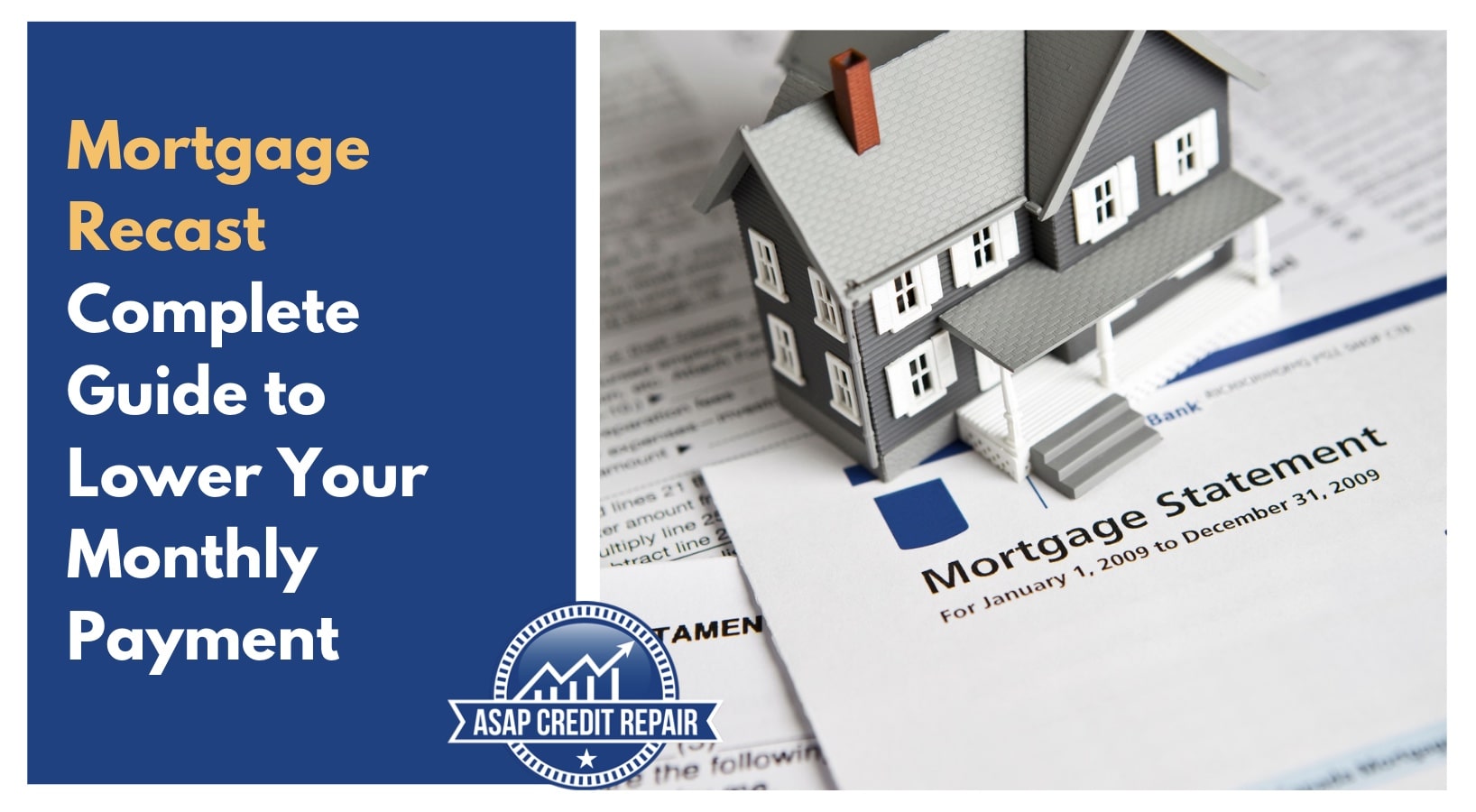A mortgage recast offers a straightforward way to reduce your monthly payment without refinancing.
Why You Can Trust This Guide
We help homeowners make smarter financial decisions every day, especially when it comes to credit, mortgages, and budgeting. With real experience in credit building and debt management, we break down complex topics into simple steps you can actually use.
A mortgage recast is one of the easiest ways to lower your monthly payment without refinancing. If your mortgage is taking up too much of your budget, read on.
This guide breaks down everything you need to know about recasting your mortgage.
What Is a Mortgage Recast?
A mortgage recast reduces your monthly payment by recalculating your loan based on a lump sum payment you make toward the principal. Your lender keeps the same interest rate and loan term but spreads the remaining balance over your existing timeline.
Think of it this way: You make a large payment that chips away at what you owe. Your lender then adjusts your monthly payment downward to reflect this smaller balance.
Here's a real-world example:
- Original loan amount: $300,000
- Interest rate: 6%
- Monthly payment: $1,799
- Balance after 3 years: $280,000
You receive a $50,000 bonus and apply it to your principal. Your new balance drops to $230,000. The lender recalculates your payment based on this amount.
Your new monthly payment: $1,378
That's a $421 monthly savings. You keep your 6% rate and don't extend your payoff date. The loan still ends on schedule.
Why Lenders Allow Recasting
Lenders benefit from recasting in several ways:
- They keep you as a customer - You're not refinancing elsewhere, so they retain your business and continue earning interest from you.
- They get a large principal payment - That lump sum reduces their risk immediately. Less money owed = less risk for them.
- They still make money - You're still paying interest on the remaining balance over the full loan term. They just recalculate the monthly amount.
- It's cheaper than default - If high payments cause you to default, the lender loses money through foreclosure. A recast keeps you paying reliably.
- Minimal work, guaranteed fee - They charge $150-$500 for simple math and paperwork. Easy money for them.
Think of it this way: Would you rather have someone pay you $50,000 NOW and continue paying you interest for 25 more years, or risk them refinancing to a competitor and losing them entirely?
What Does Recast Mean in a Mortgage?
Recast means your lender re-amortizes your loan. They take your reduced principal balance and recalculate your payment schedule. The term "recast" refers to this mathematical recalculation. Your lender essentially casts a new payment structure while maintaining your original loan terms.
Is Mortgage Recast a Good Idea?
As a credit repair expert, I see mortgage recasting as a smart financial move for specific situations. The strategy works best when you have cash available but want to preserve your favorable interest rate.
The Pros:
Lower monthly obligations. You free up hundreds of dollars each month for other financial goals. This improves your debt-to-income ratio without changing your credit mix.
No credit check required. Unlike refinancing, your lender doesn't pull your credit report. Your credit score stays unaffected by inquiries.
Keep your current rate. If you locked in a low rate years ago, you preserve it. Refinancing in a higher-rate environment would cost you thousands over time.
Minimal paperwork. Most lenders require just a simple request form. You skip the extensive documentation refinancing demands.
Faster processing. Most recasts complete within 30-60 days. Refinancing typically takes 45-60 days or longer.
The Costs:
Lenders charge a recast fee ranging from $150 to $500. Some charge nothing. This beats refinancing costs that run $2,000 to $6,000 on average.
You need substantial cash on hand. Most lenders require a minimum $5,000 lump sum payment. Many set the bar at $10,000 or higher.
The opportunity cost matters too. That money could earn returns in investments. Run the numbers to see if the monthly savings outweigh potential investment gains.
How to Recast a Mortgage
Follow these steps to recast your mortgage. I've broken down the process into simple actions anyone can complete.
Step 1: Check your loan type
Call your lender and ask: "Does my mortgage allow recasting?"
Before calling:
- Check your current mortgage balance online
- Know how much cash you can put toward principal (at least $5,000-$10,000)
- Calculate if the monthly savings makes sense for you
- Have your loan documents handy
When you call, say this:
"Hi, I'd like to inquire about recasting my mortgage. Does my loan type allow recasting, and what are your requirements?"
Ask these specific questions:
- What's your minimum lump sum requirement?
- What's the recast fee?
- How long does the process take?
- Can you email me the forms?
Important: Not all loans qualify. FHA, VA, and USDA loans typically DON'T allow recasting. Most conventional loans DO.
Step 2: Review your lender's requirements
Ask these specific questions:
- What's the minimum lump sum payment?
- How much do you charge for recasting?
- How long have I needed to hold this mortgage?
- What documents do I need?
Most lenders require you to have held the loan for at least 12 months.
Step 3: Gather your cash
Accumulate the required lump sum. Common sources include:
- Work bonuses
- Tax refunds
- Inheritance money
- Investment liquidations
- Savings accounts
Step 4: Request the recast
Contact your lender's customer service. Say: "I want to recast my mortgage." They'll send you the necessary forms. Some lenders offer online submission.
Step 5: Make your lump sum payment
Send the payment according to your lender's instructions. Get written confirmation. Mark the payment "principal prepayment for recast."
Step 6: Pay the recast fee
Submit the processing fee. Your lender will provide payment instructions with your recast paperwork.
Step 7: Wait for recalculation
Your lender processes the request within 30-60 days. They'll send you a new amortization schedule showing your reduced payment.
Step 8: Verify the new payment
Check your first statement after the recast. Confirm the payment amount matches what your lender quoted. Contact them immediately if you spot discrepancies.
How Many Times Can You Recast a Mortgage?
Most lenders limit recasts to once per year. Some allow only one or two recasts over the life of your loan. Others permit unlimited recasts if you meet the minimum payment requirements each time.
Your specific limit depends on your loan servicer's policies. Fannie Mae and Freddie Mac don't set federal restrictions on recast frequency. Each lender creates their own rules.
Call your servicer to ask: "How many times can I recast this mortgage?" Get this information in writing. Some lenders require waiting periods between recasts, typically 12 months.
Strategic borrowers use multiple recasts throughout their loan term. You might recast after receiving annual bonuses or when you sell investments. This approach steadily reduces your payment as your financial situation improves.
Mortgage Recast Calculator
You can calculate your new payment before contacting your lender. Use this formula:
New Monthly Payment = [Remaining Balance - Lump Sum] × Monthly Interest Rate / [1 - (1 + Monthly Interest Rate)^-Remaining Months]
That looks complicated. Here's an easier method:
- Find your remaining loan balance
- Subtract your planned lump sum payment
- Count how many months remain on your loan
- Use an online mortgage calculator
Enter your new principal (balance minus lump sum), your current interest rate, and remaining loan term. The calculator shows your new payment.
Example calculation:
- Current balance: $250,000
- Lump sum: $25,000
- New balance: $225,000
- Interest rate: 5.5%
- Months remaining: 300 (25 years)
Plug these numbers into any mortgage calculator. Your new payment comes out to approximately $1,383 versus $1,534 before the recast. That's $151 in monthly savings.
Online calculators from Bankrate, Zillow, or NerdWallet work perfectly for this calculation. You don't need special recast calculators.
Does a Mortgage Recast Have a Credit Score Impact?
A mortgage recast does not affect your credit score. Your lender doesn't report the recast to credit bureaus as a new account or modification.
Here's what stays the same on your credit report:
- Account opening date remains unchanged
- Credit limit (original loan amount) stays the same
- Payment history continues uninterrupted
- Account type remains "mortgage"
Your credit utilization on the mortgage appears to improve slightly. Credit bureaus see you owe less while maintaining the same credit limit. This creates a better balance-to-limit ratio on your mortgage trade line.
No hard inquiry hits your credit report. Lenders don't check your credit score or pull your credit history for recasts. This differs dramatically from refinancing, which requires a full credit check.
Your on-time payment history continues building positive credit. Keep making your new lower payments on schedule. This consistency strengthens your credit profile over time.
One indirect benefit: Lower monthly payments improve your debt-to-income ratio. This helps when you apply for other credit products. Lenders see you have more breathing room in your budget.
Is Recasting Mortgage Worth It?
Mortgage recasting makes financial sense for specific situations. You benefit most when you have substantial cash reserves but want to maintain your current interest rate.
Recast your mortgage if you:
- Have $10,000+ in liquid savings beyond your emergency fund
- Locked in an interest rate below current market rates
- Want to reduce monthly expenses without extending your loan term
- Prefer avoiding the hassle and cost of refinancing
- Don't plan to move or sell within the next few years
Skip recasting if you:
- Can get a significantly lower rate by refinancing (1% or more difference)
- Plan to sell your home within 1-2 years
- Would deplete your emergency fund to make the lump sum payment
- Could earn better returns investing that cash elsewhere
The math works best when current mortgage rates exceed your rate by 1% or more. A recast preserves your low rate while refinancing forces you into higher rates.
Run a break-even analysis. Divide the recast fee by your monthly savings. If you save $200 monthly with a $300 fee, you break even in 1.5 months. That's an excellent return.
Compare this to refinancing costs. Breaking even on refinancing typically takes 2-4 years. Recasting pays for itself almost immediately.
The bottom line: Mortgage recasting delivers powerful results for borrowers with cash on hand who value simplicity and want to preserve favorable loan terms. This underutilized strategy can save you thousands in monthly payments without the complexity of refinancing.

